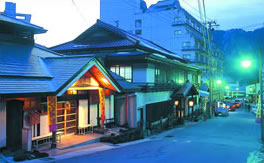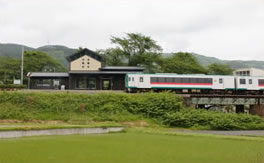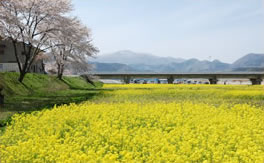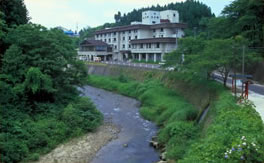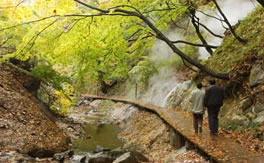Five Hot Spring Areas Each with Its Individual Characters
The Naruko-onsen-kyo Hot Spring Village is located in the upper portion of the Eai-gawa River (Arao-gawa River) that runs through the Osaki area in the north of Miyagi Prefecture, which is well known for its rice production, and consists of the five hot spring areas of “Naruko Hot Spring,” “Higashi-Naruko Hot Spring,” “Kawatabi Hot Spring,” “Nakayamadaira Hot Spring,” and “Onikobe Hot Spring.” Each of them provides highly individual village scenery and baths, and it is fun to visit and compare them with each other.
There are nearly 400 hot spring sources in the Naruko-onsen-kyo Hot Spring Village, boasting various kinds of water characteristics, and many inns and hotels even have their own sources on their property. There is a plentiful supply of hot spring water, and it is another of the area’s charms that many baths feature free-flowing hot spring water. Moreover, the Naruko-onsen-kyo offers nine of the eleven kinds of water quality of hot springs that exist in Japan. It has been known as a hot spring resort in the Tohoku Region since early times and has a reputation for the medicinal benefits of its hot springs and the excellent water quality.
Introduction to the Five Hot Spring Areas
01.Naruko Hot Spring
This is the central part of the Naruko-onsen-kyo Hot Spring Village. It has been counted as one of the “Three Renowned Hot Springs in Oshu” for a long time. It is the largest among the five hot spring areas, and modern accommodation, restaurants, and souvenir shops form a bustling townscape. The two public baths, “Taki no Yu” and “Waseda Sajiki Yu,” are the symbol of the hot spring town.
Website of the Naruko Onsen Hotel Association (Japanese Only)
02.Higashi Naruko Hot Spring
This has been known as a hot spring resort for a long time, and in the Edo Period, there was a private bath called “gotenyu” (bath for exalted personages) exclusively for the Date family as the feudal lord of Sendai. The compact 300-meter hot spring town street creates an old-fashioned atmosphere.
The street is lined with a little more than 10 old hydropathic establishments and stores.
Website of the Higashi Naruko Onsen Tourist Association (Japanese Only)
03.Kawatabi Hot Spring
This spa is located at the entrance of the Naruko-onsen-kyo Hot Spring Village along the Eai-gawa River (Arao-gawa River). It is regarded as the oldest hot spring in the Hot Spring Village. There used to be a saying “Kakke Kawatabi” (Kawatabi is good for beriberi), and we hear that rumors of its excellent efficacy even spread to Kyoto. The warm townscape with wooden inns arouses a sense of nostalgia.
Website of the Kawatabi Onsen Hotel Association (Japanese Only)
04.Nakayamadaira Hot Spring
This is a hot spring town situated among idyllic mountains and blessed with a natural setting where clouds of white steam rise along the Oya-gawa River. “Unagi yu” (Eel spa) is a sulfur spa with a creamy feel and is popular for its beautifying waters. Nakayamadaira is the hot spring area with the most abundant hot spring waters in the Naruko-onsen-kyo.
Website of the Nakayamadaira Onsen Tourist Association (Japanese Only)
05.Onikobe Hot Spring
This hot spring is situated in the Kurikoma Quasi-National Park and is famous for its two geysers, “Benten” and “Unryu.” It is sometimes called Onikobe-onsen-kyo Hot Spring Village, and includes several other hot springs with a single inn such as “Mitaki” and “Todoroki.” Onikobe enjoys great popularity as a highland resort and as a base for outdoor sports.
